Experimental and DEM Analysis on Secondary Crack Types of Rock-Like Material Containing Multiple Flaws Under Uniaxial Compression
Abstract
:1. Introduction
2. Mesoscopic Parameter Calibration and Basic Theory
2.1. Specimen Preparation and Mesoscopic Parameter Calibration
2.2. Strain Rate Tensor
3. Analysis of Numerical Simulation Results
3.1. Research on Crack Propagation Mechanism
- (1)
- The typical characteristics of Type I are described as follows. The directions of horizontal component of particle velocity on both sides of the crack are opposite, the vertical component is in the same direction and the vertical component of the velocity is almost no different or zero. It can be obviously seen that the relative motion tendency of the particle is mainly controlled by the horizontal velocity component.
- (2)
- For Type II, the directions of particle velocity on both sides of the crack are almost the same, and the values have no difference. In this case, the motion trend between the particles has certain inhibitory effects on the crack initiation and propagation.
- (3)
- For Type III, the horizontal and vertical components of the particle velocity on both sides of the crack are the same, but the values are different.
- (4)
- For Type IV, the directions of particle velocity on both sides of the crack are opposite.
3.2. Analysis and Discussions
4. Conclusions
- (1)
- By defining a variable R to quantify the crack failure mechanism, the types and mechanical behaviors of the secondary cracks between the flaws can be effectively distinguished. The initiation mechanism of secondary cracks between flaws is most complicated, and the types and mechanical behaviors of newly generated cracks are distinctive in different stress loading stages. According to the value of variable R, we can directly understand the types mechanical behaviors of secondary cracks.
- (2)
- According to the velocity and relative motion trend of the particles on both sides of the crack, the velocity field of the particles can be obviously divided into four types. The type of particle velocity field on both sides of the newly generated cracks determines the type of crack in the measurement region. At different stress loading stages, the velocity field types of the particles on both sides of the crack are constantly evolving and complicated.
- (3)
- Combined with the particle velocity field analysis and the value of the variable R, it can be seen that the macro tensile crack contains partial shear cracks, and the macro shear crack contains partial tensile cracks, indicating that the type of macro crack is not totally determined by the type of partial cracks. The secondary cracks contain tensile micro-cracks, shear micro-cracks, and compressive-shear micro-cracks, and the number of tensile micro-cracks is the largest. However, when the axial stress is reached to 35.12 MPa, the ratio ( = 22.52) indicates that the newly generated cracks are shear cracks in essence. Therefore, we can see that the type of macro-crack does not depend on the dominant type of micro-cracks.
- (4)
- At the beginning stage of secondary crack initiation, SC-1 and SC-2 appear as shear cracks between pre-existing parallel flaws, then extend up and down toward the tip of the flaws, and finally connect the tips of T2 and T4, as well as T1 and T3, in the form of arcs. The particles between pre-existing parallel flaws form a confined compressive member under uniaxial compression. Under the confinement of lateral particles, the contacts between particles are broken owing to the combined compressive and shear actions, and eventually the shear cracks are successively formed.
Author Contributions
Funding
Acknowledgments
Conflicts of Interest
References
- Zhu, W.; Li, Y.; Li, S.; Wang, S.; Zhang, Q. Quasi-three-dimensional physical model tests on a cavern complex under high in-situ stresses. Int. J. Rock Mech. Min. 2011, 48, 199–209. [Google Scholar]
- Li, Y.; Zhu, W.; Fu, J.; Guo, Y.; Qi, Y. A damage rheology model applied to analysis of splitting failure in underground caverns of Jinping I hydropower station. Int. J. Rock Mech. Min. 2014, 71, 224–234. [Google Scholar] [CrossRef]
- Li, Y.; Zhou, H.; Zhang, L.; Zhu, W.; Li, S.; Liu, J. Experimental and numerical investigations on mechanical property and reinforcement effect of bolted jointed rock mass. Constr. Build. Mater. 2016, 126, 843–856. [Google Scholar] [CrossRef]
- Li, Y.; Li, C.; Zhang, L.; Zhu, W.; Li, S.; Liu, J. An experimental investigation on mechanical property and anchorage effect of bolted jointed rock mass. Geosci. J. 2017, 21, 253–265. [Google Scholar]
- Li, Y.; Zhou, H.; Dong, Z.; Zhu, W.; Li, S.; Wang, S. Numerical investigations on stability evaluation of a jointed rock slope during excavation using an optimized DDARF method. Geomech. Eng. 2018, 14, 271–281. [Google Scholar]
- Zhou, X.; Wang, Y.; Zhang, J.; Liu, F. Fracturing behavior study of Three-Flawed specimens by uniaxial compression and 3D digital image correlation: Sensitivity to brittleness. Rock Mech. Rock Eng. 2019, 52, 691–718. [Google Scholar] [CrossRef]
- Ma, G.W.; Dong, Q.Q.; Fan, L.F.; Gao, J.W. An investigation of non-straight fissures cracking under uniaxial compression. Eng. Fract. Mech. 2018, 191, 300–310. [Google Scholar] [CrossRef]
- Tang, C.A.; Kou, S.Q. Crack propagation and coalescence in brittle materials under compression. Eng. Fract. Mech. 1998, 61, 311–324. [Google Scholar] [CrossRef]
- Park, C.H.; Bobet, A. Crack initiation, propagation and coalescence from frictional flaws in uniaxial compression. Eng. Fract. Mech. 2010, 77, 2727–2748. [Google Scholar] [CrossRef]
- Yang, S.Q.; Huang, Y.H.; Tian, W.L.; Zhu, J.B. Erratum to: An experimental investigation on strength, deformation and crack evolution behavior of sandstone containing two oval flaws under uniaxial compression. Eng. Geol. 2017, 217, 35–48. [Google Scholar] [CrossRef]
- Yang, S.Q.; Ranjith, P.G.; Jing, H.W.; Tian, W.L.; Ju, Y. An experimental investigation on thermal damage and failure mechanical behavior of granite after exposure to different high temperature treatments. Geothermics 2017, 65, 180–197. [Google Scholar] [CrossRef]
- Zhou, X.P.; Bi, J.; Qian, Q.H. Numerical simulation of crack growth and coalescence in Rock-Like materials containing multiple pre-existing flaws. Rock Mech. Rock Eng. 2015, 48, 1097–1114. [Google Scholar] [CrossRef]
- Chen, W.; Li, S.; Zhu, W.; Qiu, X. Experimental and numerical research on crack propagation in rock under compression. Chin. J. Rock Mech. Eng. 2003, 22, 18–23. [Google Scholar]
- Wu, Z.; Wong, L.N.Y. Frictional crack initiation and propagation analysis using the numerical manifold method. Comput. Geotech. 2012, 39, 38–53. [Google Scholar] [CrossRef]
- Bobet, A. The initiation of secondary cracks in compression. Eng. Fract. Mech. 2000, 66, 187–219. [Google Scholar] [CrossRef]
- Cao, P.; Liu, T.; Pu, C.; Lin, H. Crack propagation and coalescence of brittle rock-like specimens with pre-existing cracks in compression. Eng. Geol. 2015, 187, 113–121. [Google Scholar] [CrossRef]
- Shen, B.; Stephansson, O.; Einstein, H.H.; Ghahreman, B. Coalescence of fractures under shear stress experiment. J. Geophys. Res. 1995, 100, 5975–5990. [Google Scholar] [CrossRef]
- Wong, R.H.C.; Chau, K.T. Crack coalescence in a rock-like material containing two cracks. Int. J. Rock Mech. Min. 1998, 35, 147–164. [Google Scholar] [CrossRef]
- Cheng, H.; Zhou, X.; Zhu, J.; Qian, Q. The effects of crack openings on crack initiation, propagation and coalescence behavior in Rock-Like materials under uniaxial compression. Rock Mech. Rock Eng. 2016, 49, 3481–3494. [Google Scholar] [CrossRef]
- Bobet, A.; Einstein, H.H. Fracture coalescence in rock-type materials under uniaxial and biaxial compression. Int. J. Rock Mech. Min. 1998, 35, 863–888. [Google Scholar] [CrossRef]
- Wong, L.N.Y.; Einstein, H.H. Crack coalescence in molded gypsum and carrara marble: Part 1. Macroscopic observations and interpretation. Rock Mech. Rock Eng. 2009, 42, 475–511. [Google Scholar] [CrossRef]
- Wong, L.N.Y.; Einstein, H.H. Crack coalescence in molded gypsum and carrara marble: Part 2-Microscopic observations and interpretation. Rock Mech. Rock Eng. 2009, 42, 513–545. [Google Scholar] [CrossRef]
- Wong, L.N.Y.; Einstein, H.H. Systematic evaluation of cracking behavior in specimens containing single flaws under uniaxial compression. Int. J. Rock Mech. Min. 2009, 46, 239–249. [Google Scholar] [CrossRef]
- Cundall, P.A.; Strack, O. Discrete numerical-model for granular assemblies. Geotechnique 1979, 29, 47–65. [Google Scholar] [CrossRef]
- Liu, J.; Wang, J.; Wan, W. Numerical study of crack propagation in an indented rock specimen. Comput. Geotech. 2018, 96, 1–11. [Google Scholar] [CrossRef]
- Cao, R.H.; Cao, P.; Lin, H.; Ma, G.W.; Zhang, C.Y.; Jiang, C. Failure characteristics of jointed rock-like material containing multi-joints under a compressive-shear test: Experimental and numerical analyses. Arch. Civ. Mech. Eng. 2018, 18, 784–798. [Google Scholar] [CrossRef]
- Park, B.; Min, K.; Thompson, N.; Horsrud, P. Three-dimensional bonded-particle discrete element modeling of mechanical behavior of transversely isotropic rock. Int. J. Rock Mech. Min. 2018, 110, 120–132. [Google Scholar] [CrossRef]
- Cao, R.H.; Cao, P.; Lin, H.; Ma, G.W.; Fan, X.; Xiong, X.G. Mechanical behavior of an opening in a jointed rock-like specimen under uniaxial loading: Experimental studies and particle mechanics approach. Arch. Civ. Mech. Eng. 2018, 18, 198–214. [Google Scholar] [CrossRef]
- Cao, R.; Lin, H.; Cao, P. Strength and failure characteristics of brittle jointed rock-like specimens under uniaxial compression: Digital speckle technology and a particle mechanics approach. Int. J. Min. Sci. Technol. 2018, 28, 669–677. [Google Scholar] [CrossRef]
- Hazzard, J.F.; Young, R.P. Moment tensors and micromechanical models. Tectonophysics 2002, 356, 181–197. [Google Scholar] [CrossRef]
- Zhang, X.; Zhang, Q. Distinction of crack nature in brittle Rock-Like materials: A numerical study based on moment tensors. Rock Mech. Rock Eng. 2017, 50, 2837–2845. [Google Scholar] [CrossRef]
- Boyd, O.S.; Dreger, D.S.; Gritto, R.; Garcia, J. Analysis of seismic moment tensors and in situ stress during Enhanced Geothermal System development at the Geysers geothermal field, California. Geophys. J. Int. 2018, 215, 1483–1500. [Google Scholar] [CrossRef]
- Stroujkova, A. Relative moment tensor inversion with application to shallow underground explosions and earthquakes. Bull. Seismol. Soc. Am. 2018, 108, 2724–2738. [Google Scholar] [CrossRef]
- Ge, W.; Wang, M.; Shen, Z.; Yuan, D.; Zheng, W. Intersiesmic kinematics and defromation patterns on the upper crust of Qaidam-Qilianshan block. Chin. J. Geophys. Chin. 2013, 56, 2994–3010. [Google Scholar]
- Kostrov, B.V.; Das, S. Structural Earthquake Source Mechanics; Science Press: Beijing, China, 1994. [Google Scholar]
- Itasca Consulting Group Inc. Users’ Manual for Particle Flow Code (PFC); Version 5.0; Itasca Consulting Group Inc.: Minneapolis, MN, USA, 2014. [Google Scholar]
- Lisjak, A.; Grasselli, G. A review of discrete modeling techniques for fracturing processes in discontinuous rock masses. J. Rock Mech. Geotec. Eng. 2014, 6, 301–314. [Google Scholar] [CrossRef] [Green Version]
- Zhang, X.; Wong, L.N.Y. Loading rate effects on cracking behavior of flaw-contained specimens under uniaxial compression. Int. J. Fracture 2013, 180, 93–110. [Google Scholar] [CrossRef]
- Yoon, J. Application of experimental design and optimization to PFC model calibration in uniaxial compression simulation. Int. J. Rock Mech. Min. 2007, 44, 871–889. [Google Scholar] [CrossRef]
- Cho, N.; Martin, C.D.; Sego, D.C. A clumped particle model for rock. Int. J. Rock Mech. Min. 2007, 44, 997–1010. [Google Scholar] [CrossRef]
- Ghazvinian, A.; Sarfarazi, V.; Schubert, W.; Blumel, M. A study of the failure mechanism of planar Non-Persistent open joints using PFC2D. Rock Mech. Rock Eng. 2012, 45, 677–693. [Google Scholar] [CrossRef]
- Baker, C.; Young, R.P. Evidence for extensile crack initiation in point source time-dependent moment tensor solutions. Bull. Seismol. Soc. Am. 1997, 87, 1442–1453. [Google Scholar]
- Martin, C.D.; Chandler, N.A. The progressive fracture of lac du bonnet granite. Int. J. Rock Mech. Min. Sci. Geomech. Abstr. 1994, 31, 643–659. [Google Scholar] [CrossRef]
- Ming, H.J.; Feng, X.T.; Chen, B.R.; Zhang, C.Q. Analysis of rockburst mechanism for deep tunnel based on moment tensor. Rock Soil Mech. 2013, 34, 163–172. [Google Scholar]
- Feignier, B.; Young, R.P. Moment tensor inversion of induced microseisnmic events: Evidence of non-shear failures in the −4 < m < −2 moment magnitude range. Geophys. Res. Lett. 1992, 19, 1503–1506. [Google Scholar]

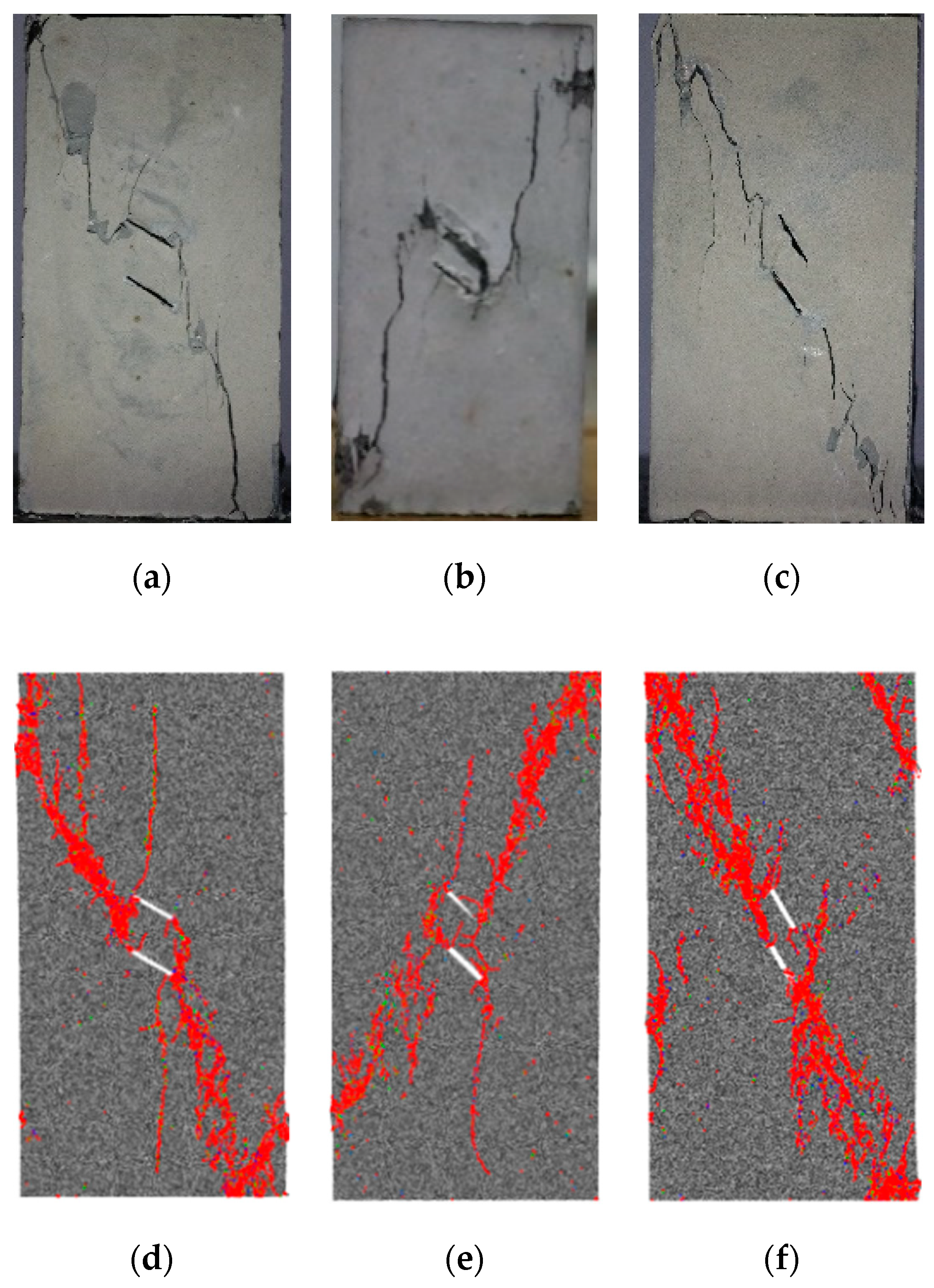
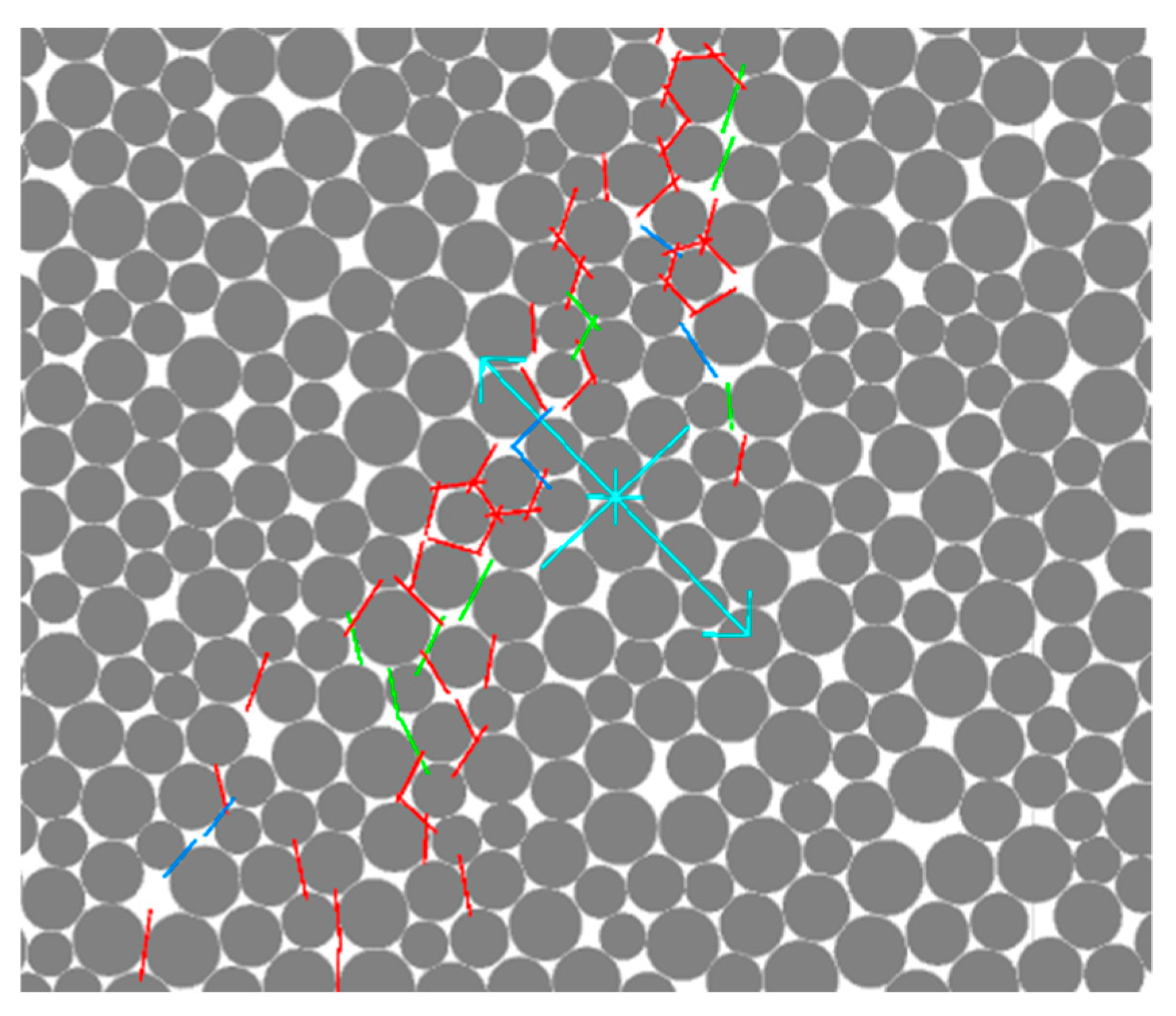

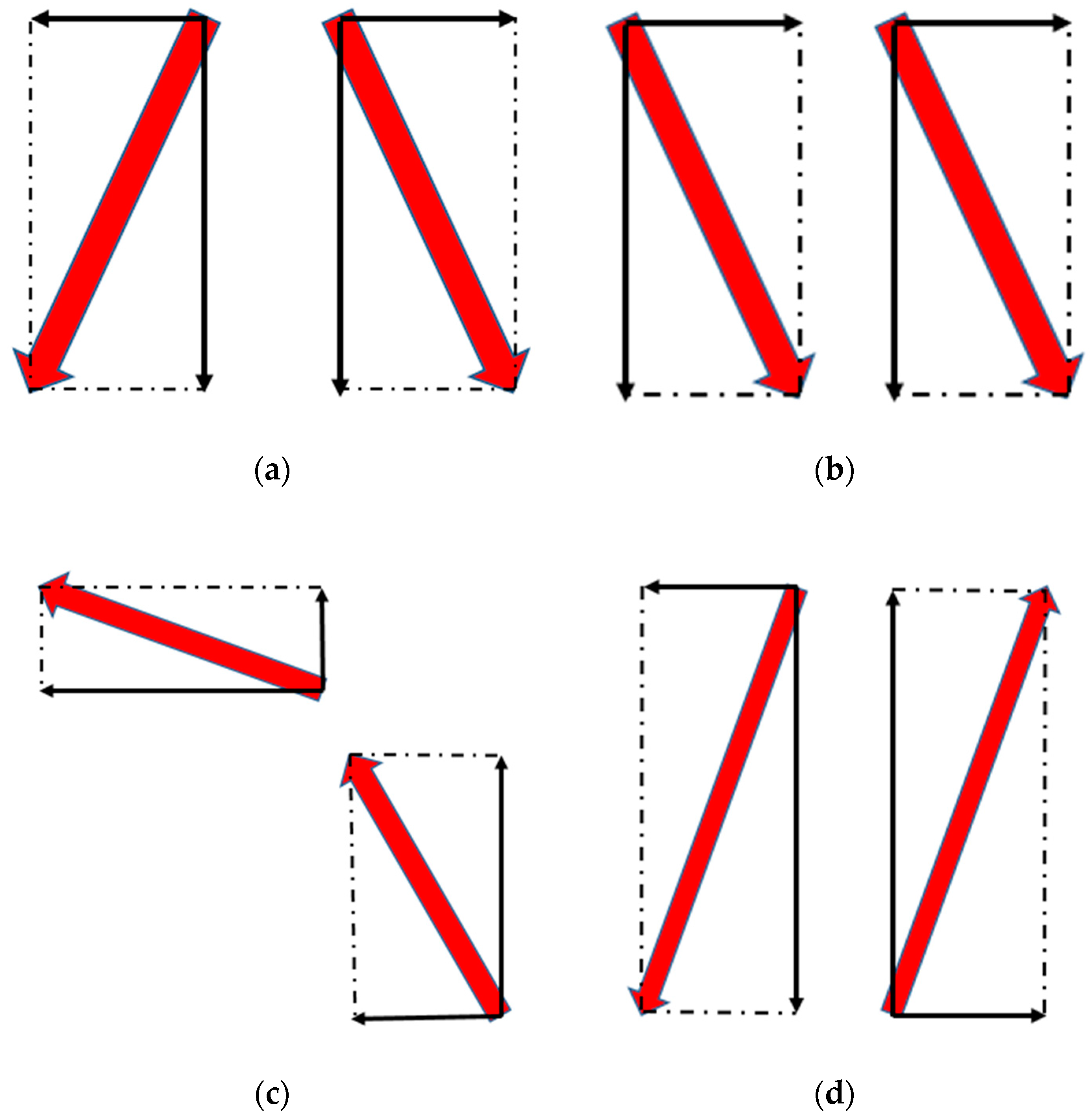

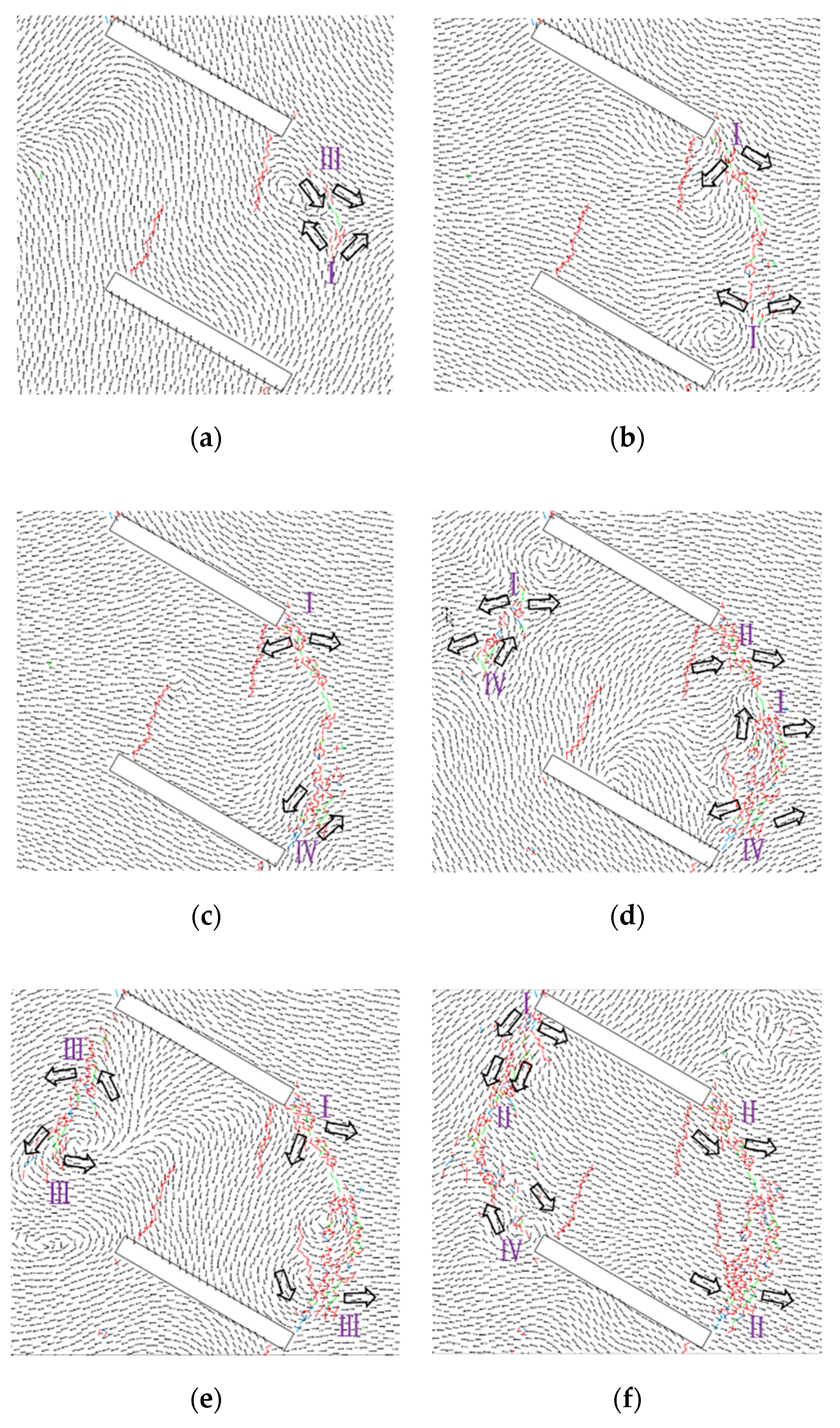
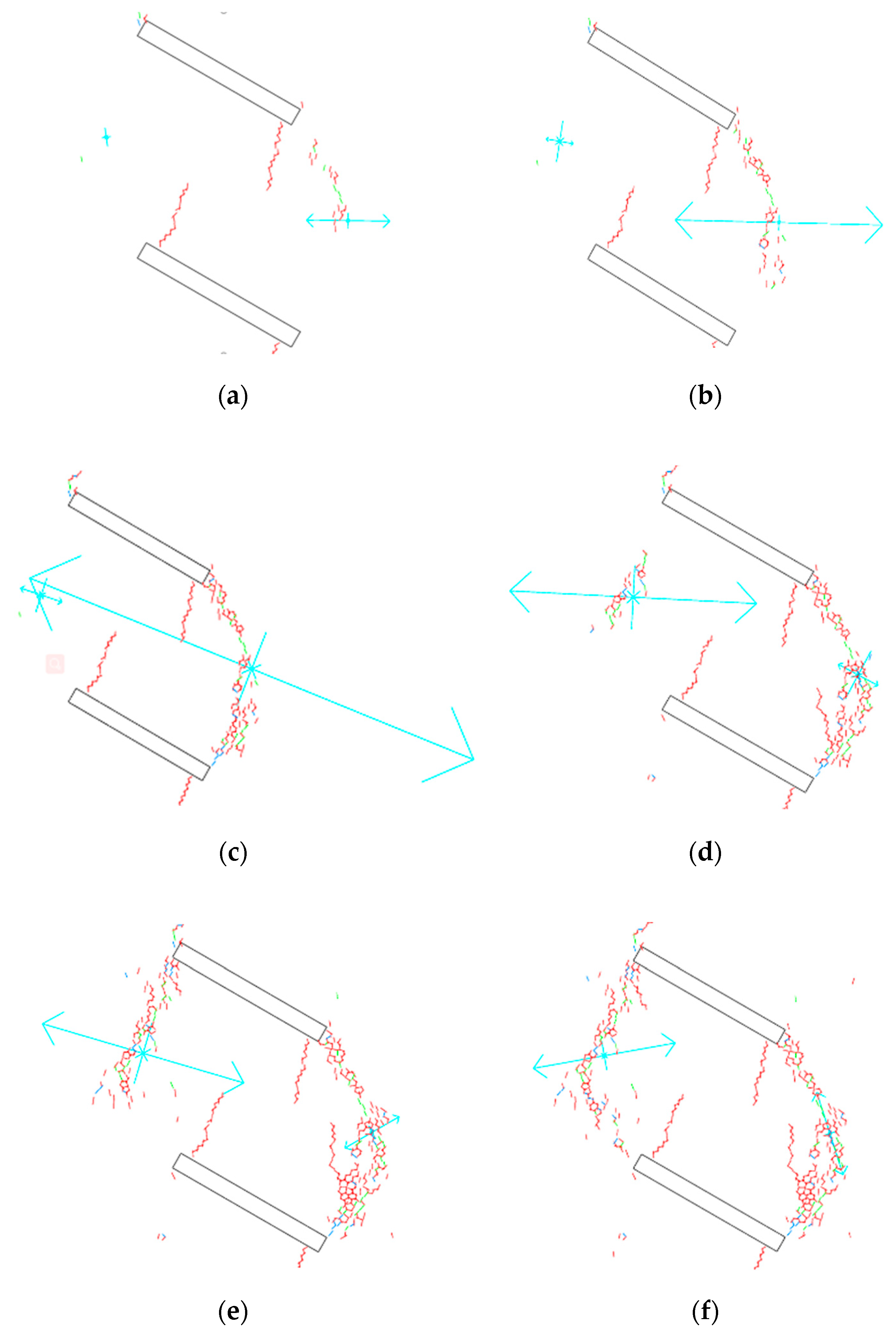
| Material | Compressive Strength (MPa) | Tensile Strength (MPa) | Young’s Modulus E (GPa) | Poisson’s Ratio | Density (g/cm3) |
|---|---|---|---|---|---|
| Cement mortar | 58.25 | 5.62 | 11.63 | 0.20 | 2.38 |
| Sandstone | 20~170 | 4~25 | 3~35 | 0.02~0.25 | 2.10~2.40 |
| Properties | Specimens for Laboratory Tests | Specimens for Numerical Simulation |
|---|---|---|
| Density (/) | 2.38 | 2.38 |
| Young’s modulus E (GPa) | 11.63 | 11.95 |
| Poisson’s ratio | 0.20 | 0.21 |
| Uniaxial compressive strength (MPa) | 58.25 | 57.30 |
| Particle Parameters | Values |
|---|---|
| Minimum radius (mm) | 0.18 |
| Particle radius ratio | 1.66 |
| Density (/) | 2.38 |
| Friction | 0.55 |
| Effective modulus (GPa) | 5.5 |
| Normal/shear stiffness ratio | 2.0 |
| Tensile strength (MPa) | 22.5 2.0 |
| Cohesion (MPa) | 19.5 2.0 |
| Angle of internal friction (0) | 35 |
| Bond effective modulus (GPa) | 5.5 |
| Bond normal/shear stiffness ratio | 2.0 |
| Loading Stages | Loading Stresses (MPa) | ||
|---|---|---|---|
| a | 35.12 | 23.52 | - |
| b | 36.96 | 37.77 | - |
| c | 37.24 | 35.75 | - |
| d | 43.40 | - | 27.53 |
| e | 43.61 | - | 41.69 |
| f | 45.61 | −45.60 | 23.02 |
© 2019 by the authors. Licensee MDPI, Basel, Switzerland. This article is an open access article distributed under the terms and conditions of the Creative Commons Attribution (CC BY) license (http://creativecommons.org/licenses/by/4.0/).
Share and Cite
Li, Y.; Cai, W.; Li, X.; Zhu, W.; Zhang, Q.; Wang, S. Experimental and DEM Analysis on Secondary Crack Types of Rock-Like Material Containing Multiple Flaws Under Uniaxial Compression. Appl. Sci. 2019, 9, 1749. https://doi.org/10.3390/app9091749
Li Y, Cai W, Li X, Zhu W, Zhang Q, Wang S. Experimental and DEM Analysis on Secondary Crack Types of Rock-Like Material Containing Multiple Flaws Under Uniaxial Compression. Applied Sciences. 2019; 9(9):1749. https://doi.org/10.3390/app9091749
Chicago/Turabian StyleLi, Yong, Weibing Cai, Xiaojing Li, Weishen Zhu, Qiangyong Zhang, and Shugang Wang. 2019. "Experimental and DEM Analysis on Secondary Crack Types of Rock-Like Material Containing Multiple Flaws Under Uniaxial Compression" Applied Sciences 9, no. 9: 1749. https://doi.org/10.3390/app9091749





